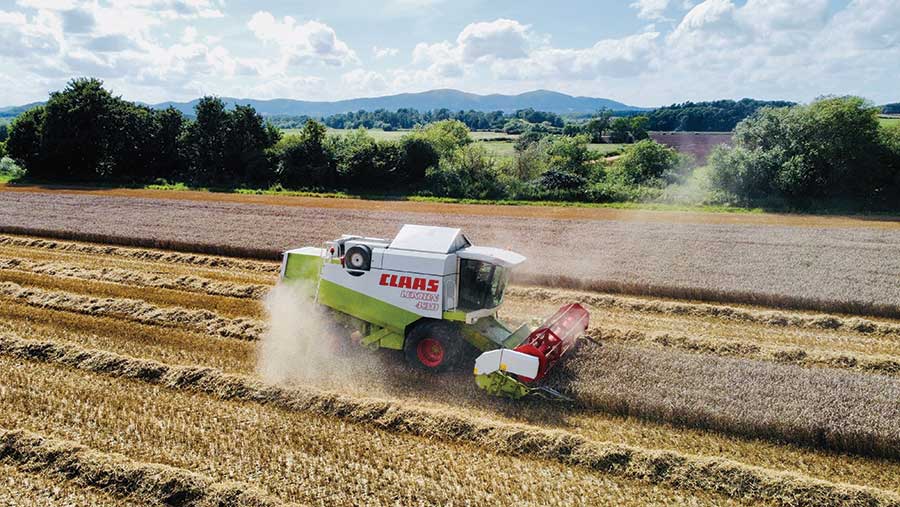Harvest 2023: Moisture contents are ridiculously variable
 Combining winter wheat at Upper Whiston Farm near Rotherham © Natalie Hodgson
Combining winter wheat at Upper Whiston Farm near Rotherham © Natalie Hodgson Grain traders are reporting wide variations in grain qualities, with this harvest very much proving the luck of the draw, depending on local conditions.
Even so, milling wheat and malting barley have had average to above-average yields this year.
Inverness
Highland Grain near Black Isle has so far received only 600t of spring malting barley; there is a huge area of spring barley that is not ready for harvesting in Scotland.
General manager Gary Catto says: “We’ve seen mixed quality so far: everything from beautiful, big, bold, clean low-nitrogen barley to one sample that was horrendously thin, light, with lots of skinning.”
See also: Why blackgrass is so bad in 2023 and what to do about it
Samples are ranging from 63.8kg/hl to 66.2kg/hl specific weight and 1.3-1.6% nitrogen content, with most at 2-8% skinning. “We’ve rejected some that was 12% skinned,” says Gary.
Laureate is the most common variety in the area, although Highland Grain has also received Sassy and Diablo. “Laureate works OK for the maltsters and distillers, so the whole supply chain is happy,” he says.
Tyne and Wear
Further south, Tynegrain has seen winter wheat coming in with Hagberg numbers dropping into the 100s. “Moisture contents are ridiculously variable because the weather is so localised,” says grain trader Jonathon Pearse.
Lodging has also been affecting qualities, he says. “Quality on standing wheat is alright, but wheat that’s lodged has got no specific weight – a lot is struggling to hit 72kg/hl.”
Shropshire
Winter wheat harvest has just started at Upper Stanway Farm near Ludlow, where David Riley has 250ha to go at. So far he has cut Dawsum at 14-15% moisture content.
“Yields are doing well, pushing 10t/ha on average, which is good,” he says. Next he has Palladium, Gleam and Graham winter wheat to cut.
Before the wheat came 100ha of Memento and Surge winter barley, which yielded 8-8.6t/ha, cut at 17-18% moisture content before drying.
The 80ha of Expedient oilseed rape performed worse than last year, yielding 3.2t/ha at 9-10% moisture, and with quality expected to be negatively affected.
After winter wheat will be spring beans, for which David has low expectations.
“It went dry in the spring, so won’t be the bumper crop we aim for,” he says. “The disease pressure was high, as the weather was damp and warm, which affected yields.”

Cutting winter wheat with the Malvern Hills in the background © Richard Stratton
Hampshire
At Trinity Grain, which owns grain stores in Wiltshire, Berkshire and Hampshire, milling wheat and malting barley are hitting market specifications and yields have been average to above average.
“To date we have taken in 75,000t across our three stores,” says managing director David Evans.
Trinity expects to receive the full commitment of more than 200,000t. Screenings are low and average moisture contents are 16.5% for wheat and 16% for barley.
Milling wheat is averaging 76kg/hl specific weight, with Group 1 and Group 2 varieties around 300 Hagberg and feed wheat around 265.
“Top-grade milling wheat ranges from 12% to 13% protein content, with Group 4 hard, mixed hard and low grades averaging 11.5%,” says David.
Spring malting barley is averaging 65kg/hl specific weight and 1.6% nitrogen content.
Devon
Devon Grain has taken in 3,500t of feed wheat, averaging 73kg/hl specific weight and 17% moisture content, so dryers are working hard.
Farmers are about a third of the way through their wheat harvest, with winter oats about half done and averaging 52.6kg/hl specific weight.
“Quality is not as good as last year,” says general manager Duncan Lyon. But screenings are reasonable, averaging 2.75% in winter oats.
The oilseed rape harvest is finished, with an average oil content of just under 45%.
